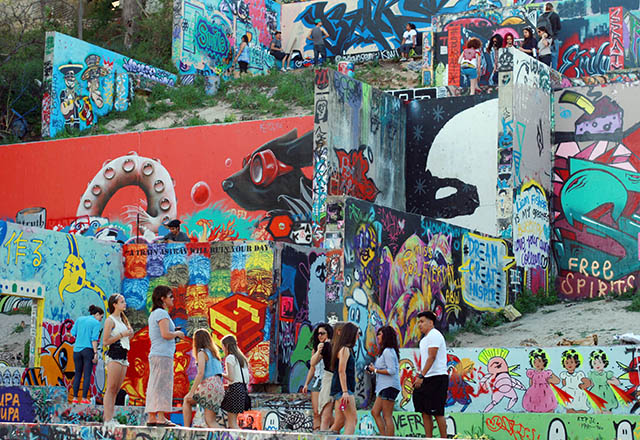Austin Wages $500,000 Battle Against Graffiti

Visitors to Austin’s Graffiti Park make their way up and down the vibrant display. Photo by Silvana Di Ravenna.
By Esmeralda Coronado Valles
For Reporting Texas
Every couple of weeks, the City of Austin sends workers to cover the graffiti on a wall along North Lamar Boulevard with a fresh coat of paint. The graffiti is back within a day or so.
The more effort the city puts into covering up the graffiti under a bridge near Fifth Street, the more graffiti artists work to keep it up.
“There’s a few of them that get together and keep the city workers really busy,” said one 25-year-old Austin-area graffiti artist. Reporting Texas agreed not to use his name because he fears legal consequences if his identity were known. “They’re making a statement. They are saying ‘(expletive) you.’ They don’t care. But it doesn’t matter how many people bust the spot, the city will paint over it.”
The city plays a game of cat and mouse with graffiti artists and taggers, spending more than $500,000 a year to remove or paint over their work.
The city has budgeted $516,219 for graffiti removal for the fiscal year that started Oct. 1, according to Julia Narum, in charge of the city’s graffiti removal program. Narum said the budget keeps growing because of rising costs and increasing graffiti. In 2013, the city spent $509,476 removing graffiti, about 12 percent more than in 2012.
The graffiti removal program keeps costs low by using recycled paint from Austin Resource Recovery, Austin’s trash and recycling department, but sometimes it needs to buy paint from retailers to match the original paint and do “the best possible job” covering up the graffiti, said Ruben Sandoval, a city employee who coordinates volunteers who remove the graffiti.
Sandoval said the city provides the service because property owners think graffiti is “vandalism” and “not good for their business.”
“If we left graffiti up, we would have lots of unhappy City of Austin citizens,” he said. “We are just here to respond to citizen complaints of graffiti, and we work with the property owners to get it cleaned up as soon as possible.”
Carole Barasch, spokeswoman for the Austin/Travis County Health and Human Services Department, said high-traffic areas — such as the wall on North Lamar at Fifth — are frequent graffiti targets. The department is responsible for graffiti removal, and employs a crew of young people to do the work.
Barasch said locations such as Lamar, Burnet Road, South Congress Avenue, downtown and near the University of Texas campus also have high levels of graffiti.
Besides the continuous effort to remove graffiti, Barasch said Austin also has an educational program through its Graffiti Volunteer Program. City ordinances also ban the sale of spray paint to minors in an effort to deter graffiti.
Although graffiti is a crime, the city respects some examples that are iconic, like the “Hi how are you” frog mural on a building at 21st and Guadalupe streets. Owners of the record store that once occupied the building commissioned artist and musician Daniel Johnston to do the painting in 1993; subsequent owners have kept it.
The department also generally does not touch work in Graffiti Park, a lot in the Castle Hill neighborhood west of downtown that is open to graffiti artists, Barasch said. And unless the city gets a complaint from property owners, they don’t do anything about it.
“Some think that parks such as this have value to deter graffiti, so we try to accommodate this endeavor,” she said. “We do not usually go to Graffiti Park and just remove the murals. We do occasionally have to go because they become so overrun with tags, and sometimes these tags are inappropriate or gang-related.”
Tagging, graffiti and street art are sometimes used interchangeably, though they have subtly different meanings. Tagging is generally a signature, not art. Graffiti can be more complex, like an unapproved painting. Street art is even more professional and is sometimes commissioned.
Graffiti Park, at 11th and Baylor streets, is organized by HOPE, Helping Other People Everywhere, an organization that promotes artistic contributions to Austin.
The group’s Facebook page says Graffiti Park is “one of the largest outdoor galleries in Texas and was developed to provide muralists, graffiti artists and community groups the opportunity to display larger-scale art pieces driven by inspirational, positive and educational messaging.” Prospective artists must sign up for a pass to work there.
Austin graffiti artist Nathan Nordstrom, also known as Sloke, said he doesn’t paint much there anymore.
“Castle Hill has become more of an attraction as opposed to a place of doing art,” he said. “Work gets scribbled on” by other graffiti artists. “They regulate with passes, but there’s no fence or security for artists. HOPE wants to have good work, and the landlords don’t like tagging and amateur art, but there’s nobody there to really enforce it.”
Nordstrom’s work can be seen on walls around North, East and South Austin. One of his most recent works includes a large commissioned mural off East Cesar Chavez Street and Pedernales Street.
Nordstrom, who has been arrested three times in his 12-year career, said Austin is “not the perfect place for graffiti.”
“It’s not open to graffiti art. It’s trying, but way behind the times,” he said. “I mean, how many bluebonnets, UT Towers and Longhorns can we stand?”
Nordstrom said he hopes Austin will allow more street art.
“I think it will be more accepting in the future,” he said. “It’s not accepted here as much as in Europe. They have graffiti festivals and are more supportive. I don’t think the city really wants to get involved.”